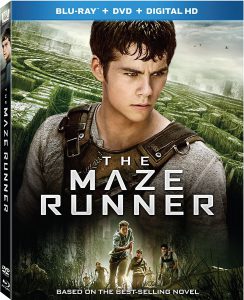Considering how shallow and incomplete the story is, “The Maze Runner” is a fairy engaging tale about teenage boys forming a society while trapped in the center of a gigantic maze. But as the first of four book adaptations in James Dashner’s young-adult series, it leaves a ton of unanswered questions, and that ultimately renders this installment unsatisfying when compared to the likes of “The Hunger Games,” “Divergent” and, of course, “Harry Potter,” which built up their sci-fi/fantasy worlds more substantially out of the gate.
Thomas (Dylan O’Brien) is an engaging lead character – the latest boy sent via elevator to The Glade, the large clearing in the center of the maze. Once a month for three years, a new teen has been sent up the elevator, with some supplies but without any memories other than his first name. Thomas develops some likable allies, including the Smurfette of the group (the only girl), Teresa (Kaya Scodelario, who has been hailed as the British Kristen Stewart).
The production design is excellent, particularly the massive inner walls of the maze, the entrance of which ominously closes at night and opens in the morning. The members of this small society (the “Gladers”) who have been selected as maze runners – presumably for their speed, bravery and skill with climbing tools and weapons – map a little bit more of the maze each day, searching for an exit. It’s not merely a mystery, but also dangerous, as the maze is patrolled by Grievers, giant spiders crossed with “Alien” xenomorphs.
Here’s a SPOILER WARNING for the rest of my post, as I dig into some key moments:
Teresa arrives with a note that says “She is the last one ever,” along with two vials of serum that cure Griever stings while also providing glimpses of one’s pre-Glade memories. Does the note mean Teresa is the last teen to be sent to the glade, or does it mean she’s the last female of breeding age on Earth? If the latter scenario is the case, then the human race is doomed, as one female is not enough to re-start a civilization. However, the Biblical tale of Adam and Eve famously makes this scientific mistake, so it’s possible “The Maze Runner” saga does too.
When they reach the maze control room, W.C.K.D. leader Ava (Patricia Clarkson) – via video recording — tells the teens they were placed in the center of the maze as an experiment. The Earth was hit by a solar flare, and while that caused no permanent damage to the climate, it did deliver a plague that eats away at people’s brains. But young people are immune. So W.C.K.D. has set up the glade and the maze as a way to study young people’s brain function. A little while later, the teens are grabbed via what is presumably a W.C.K.D. helicopter and we cut to Ava telling her board members that Phase 2 has begun.

At first blush, it seems unlikely that this high-tech experiment would be conducted in a time when the human race is in dire straits. Consider the expense of the walls themselves, then throw in the fact that they move and can be controlled from a central bunker. The cost would be astronomical, and the potential payoff highly questionable. (There’s also the inherent immorality of what they’re doing to the kids – Ava even admits that W.C.K.D. has its detractors — but I suppose that can be explained by the extreme circumstances.) While a large corporation like W.C.K.D. could afford to have the maze built, it strikes me that a fairly stable society and economy would have to exist in order to provide the laborers.
But at the end of the film, we see – from the helicopter – a large city that seems to have been wiped out by a sandstorm, presumably a side effect of the solar flare. Earlier, we had seen Ava’s video footage of people being killed by the plague (although that could’ve been W.C.K.D.’s lie, as she also faked her own suicide in the video). Clearly, “The Maze Runner” exists in a post-apocalyptic world, but the precise degree and nature of the devastation is unclear at movie’s end, and that is way too big of an unanswered question.
But “The Maze Runner” at least has something to say about the nature of societies, right? Perhaps. To me, the Gladers demonstrate the inherent stability of a small-government society as opposed to a society overseen by a large, centralized government. Gally (Will Poulter from “We’re the Millers”) is the leader, but he’s not a king, nor could he ever be, as he has no way to be backed by outside money or firepower. While he oversteps his bounds at times, banishing Griever-stung boys into the maze and attempting to offer up Thomas’ splinter group as sacrifices to appease the Grievers, Gally isn’t an insane dictator. Thomas’ group escapes after a brief fight, and indeed recruits some of Gally’s supporters. That group is then free to pursue greener pastures if they can get outside the maze.
However, I’m playing a game of “Bring your own subtext” here. While it’s possible that the future films will explore the evils of crony capitalism and oligarchies as a way to contrast the society of the Glade – perhaps even giving some pathos to Gally’s dying rant about how they should have never left the maze — the text of “The Maze Runner” is far too thin to make that assumption.
To its credit, “The Maze Runner” does take us to the other side of the wall, something that “Divergent” (also the first installment of a series) didn’t do, nor did the TV series “Almost Human” (although it was the victim of an early cancellation). But “Divergent” built up its world and showed us the nature of the conflict over the course of the film – the mysterious wall is saved for a future installment as one unanswered question.
“The Maze Runner” is almost entirely built on unanswered questions. At the start, Thomas is dropped into the middle of the maze. At the end – if you set aside the W.C.K.D. misinformation – he’s at the same point. Sure, he has physically made it through the maze, but intellectually, the maze of the plot has barely started.

